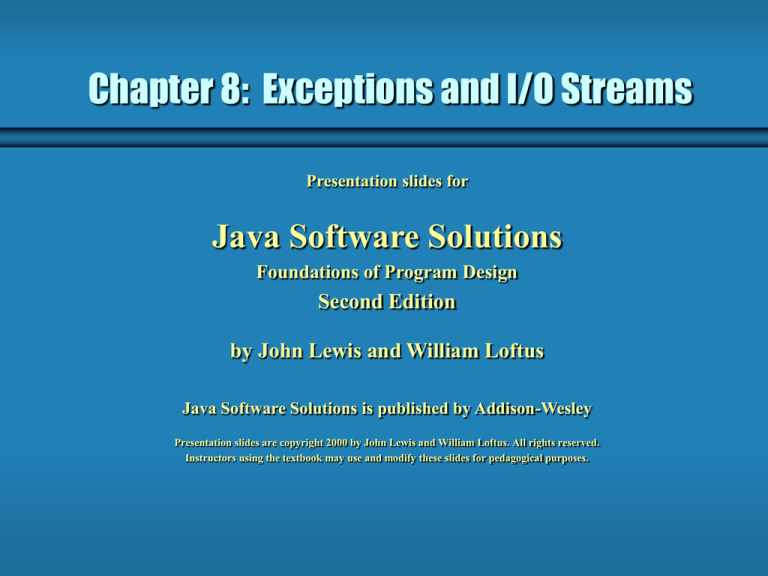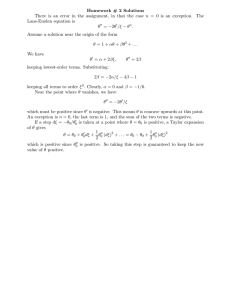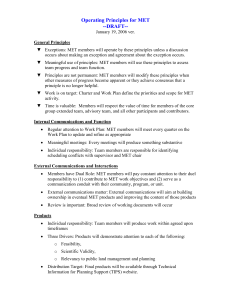
Chapter 8: Exceptions and I/O Streams
Presentation slides for
Java Software Solutions
Foundations of Program Design
Second Edition
by John Lewis and William Loftus
Java Software Solutions is published by Addison-Wesley
Presentation slides are copyright 2000 by John Lewis and William Loftus. All rights reserved.
Instructors using the textbook may use and modify these slides for pedagogical purposes.
Exceptions and I/O Streams
We can now further explore two related topics: exceptions
and input / output streams
Chapter 8 focuses on:
•
•
•
•
•
•
•
the try-catch statement
exception propagation
creating and throwing exceptions
types of I/O streams
Keyboard class processing
reading and writing text files
object serialization
2
Exceptions
An exception is an object that describes an unusual or
erroneous situation
Exceptions are thrown by a program, and may be caught
and handled by another part of the program
A program can therefore be separated into a normal
execution flow and an exception execution flow
An error is also represented as an object in Java, but
usually represents a unrecoverable situation and should not
be caught
3
Exception Handling
A program can deal with an exception in one of three ways:
• ignore it
• handle it where it occurs
• handle it an another place in the program
The manner in which an exception is processed is an
important design consideration
4
Exception Handling
If an exception is ignored by the program, the program will
terminate and produce an appropriate message
The message includes a call stack trace that indicates on
which line the exception occurred
The call stack trace also shows the method call trail that
lead to the execution of the offending line
See Zero.java (page 379)
5
The try Statement
To process an exception when it occurs, the line that throws
the exception is executed within a try block
A try block is followed by one or more catch clauses, which
contain code to process an exception
Each catch clause has an associated exception type
When an exception occurs, processing continues at the first
catch clause that matches the exception type
See ProductCodes.java (page 381)
6
The finally Clause
A try statement can have an optional clause designated by
the reserved word finally
If no exception is generated, the statements in the finally
clause are executed after the statements in the try block
complete
Also, if an exception is generated, the statements in the
finally clause are executed after the statements in the
appropriate catch clause complete
7
Exception Propagation
If it is not appropriate to handle the exception where it
occurs, it can be handled at a higher level
Exceptions propagate up through the method calling
hierarchy until they are caught and handled or until they
reach the outermost level
A try block that contains a call to a method in which an
exception is thrown can be used to catch that exception
See Propagation.java (page 384)
See ExceptionScope.java (page 385)
8
The throw Statement
A programmer can define an exception by extending the
appropriate class
Exceptions are thrown using the throw statement
See CreatingExceptions.java (page 388)
See OutOfRangeException.java (page 389)
Usually a throw statement is nested inside an if statement
that evaluates the condition to see if the exception should be
thrown
9
Checked Exceptions
An exception is either checked or unchecked
A checked exception can only be thrown within a try block
or within a method that is designated to throw that
exception
The compiler will complain if a checked exception is not
handled appropriately
An unchecked exception does not require explicit handling,
though it could be processed that way
10
I/O Streams
A stream is a sequence of bytes that flow from a source to a
destination
In a program, we read information from an input stream
and write information to an output stream
A program can manage multiple streams at a time
The java.io package contains many classes that allow us to
define various streams with specific characteristics
I/O Stream Categories
The classes in the I/O package divide input and output
streams into other categories
An I/O stream is either a
• character stream, which deals with text data
• byte stream, which deal with byte data
An I/O stream is also either a
• data stream, which acts as either a source or destination
• processing stream, which alters or manages information in the
stream
Standard I/O
There are three standard I/O streams:
• standard input – defined by System.in
• standard output – defined by System.out
• standard error – defined by System.err
We use System.out when we execute println
statements
System.in is declared to be a generic InputStream
reference, and therefore usually must be mapped to a more
useful stream with specific characteristics
The Keyboard Class
The Keyboard class was written by the authors of your
textbook to facilitate reading data from standard input
Now we can examine the processing of the Keyboard class
in more detail
The Keyboard class:
•
•
•
•
•
declares a useful standard input stream
handles exceptions that may be thrown
parses input lines into separate values
converts input stings into the expected type
handles conversion problems
The Standard Input Stream
The Keyboard class declares the following input stream:
InputStreamReader isr =
new InputStreamReader (System.in)
BufferedReader stdin = new BufferedReader (isr);
The InputStreamReader object converts the original
byte stream into a character stream
The BufferedReader object allows us to use the
readLine method to get an entire line of input
Text Files
Information can be read from and written to text files by
declaring and using the correct I/O streams
The FileReader class represents an input file containing
character data
See Inventory.java (page 397)
See InventoryItem.java (page 400)
The FileWriter class represents a text output file
See TestData.java (page 402)
Object Serialization
Object serialization is the act of saving an object, and its
current state, so that it can be used again in another
program
The idea that an object can “live” beyond the program that
created it is called persistence
Object serialization is accomplished using the classes
ObjectOutputStream and ObjectInputStream
Serialization takes into account any other objects that are
referenced by an object being serialized, saving them too



